Iran & The Nuclear Talks: The View from Tehran
 Monday, December 21, 2009 at 7:54
Monday, December 21, 2009 at 7:54  Mahmoud Reza Golshanpazhooh of the Tehran International Studies and Research Institute writes for Iran Review about the current state of discussions over Iran's uranium enrichment programme: "The issue is not too complicated and under normal circumstances, the chances of finding a solution are greater than before."
Mahmoud Reza Golshanpazhooh of the Tehran International Studies and Research Institute writes for Iran Review about the current state of discussions over Iran's uranium enrichment programme: "The issue is not too complicated and under normal circumstances, the chances of finding a solution are greater than before."First of all, let me point out certain facts about Iran’s nuclear case:
1. Iran signed the Non-Proliferation Treaty (NPT) in 1968 and ratified it in 1970. In 1974, the country signed a bilateral agreement with the International Atomic Energy Agency (IAEA), which is known as the Nuclear Safeguards Act, to allow IAEA inspections of its nuclear facilities. The agreement has been registered under No. INFCIRC/214 as Information Circular 153 (INFCIRC/153). Accordingly, the Agency has conducted many inspections of the Islamic Republic of Iran’s nuclear facilities, all of which attested to the peaceful nature of Iran’s nuclear activities.
Iran: Why the US Sanctions Game on Tehran is All Wrong
The Latest from Iran (21 December): The Montazeri Funeral
2. The West’s treatment of Iran nuclear case before presidency of Mr. Mahmoud Ahmadinejad made not only the Iranian elite, but also the public conclude that the end result would be losses, giving concessions with no result, submission to West’s bullying, and foregoing an inalienable and natural right.
Thereafter, all forms of negotiations were considered negative, and anything that led to progress in nuclear research was construed an emblem of patriotism, which strengthened a sense of self-confidence and national self-reliance.
3. Interactions between Iran and the Agency have been based more on goodwill than confrontation. During all the time that the Agency has been in charge of Iran’s nuclear case, adoption of a cooperative policy by the Islamic Republic of Iran toward the Agency has prompted the IAEA director general to declare more than once that there has been no evidence to prove any deviation in Iran’s nuclear program toward non-peaceful applications, and the Agency has been able to verify reports submitted by Iran. All his reports attested to Iran having implemented the Safeguards Act. Iran has also provided access to declared nuclear material by the Agency and has presented necessary reports related to those materials and other nuclear activities to the International Atomic Energy Agency.
The Agency has admitted in its reports that all nuclear materials produced at Natanz facility, all installed cascades and the whole UF6 produced at Isfahan UCF are under full control of IAEA and have been accounted for. On the other hand, the Agency has announced in reports issued in September and November 2005 as well as February 2008 that all outstanding issues related to Iran’s nuclear activities have been resolved and the case has been closed.
4. As for allegations about Iran pursuing a military nuclear program, the director general of the International Atomic Energy Agency has frequently noted that there has been no evidence to uphold those allegations. In his report in May 26, 2008, Mohamed El Baradei noted that the Agency has found no information about practical design or production of nuclear weapon components in Iran. In the same report, the director general noted that there has been no practical use of nuclear materials for purposes mentioned in alleged studies. Also, one day after publication of a report by the American intelligence agencies on Iran’s nuclear program, the IAEA director general issued a statement noting that the intelligence estimate on Iran’s nuclear program totally conformed to what the Agency had asserted in the past few years about absence of any conclusive evidence to prove that there was a weapons program underway in Iran.
What is the main point which every fair mind would associate with the above paragraphs? The conclusions reached after reading the above paragraphs will be, at least, as follows:
1. At no time in the past few years have Iran’s nuclear activities been out of control;
2. Iran’s willingness to interact with the Agency is not just a propaganda drive and has been proven on many occasions; and
3. The political dimension of the nuclear program greatly outweighs its legal dimension.
Interestingly, despite all cooperation that Iran has shown with the International Atomic Energy Agency and its good interaction with P5+1 [US, UK, France, Germany, Russia, China], and although Iran remains committed to NPT, the nuclear case has been reflected in Western media in such a way that as if this is the greatest threat to international peace and security.
Iif Iran was bent on opposing the demands of international community or not complying with its obligations, halting negotiations with P5+1 or quitting the NPT would have been the most available options for a country conducting a clandestine nuclear program. The claim that Iran is trying to buy time is not true: the time needed to increase uranium enrichment from below 5 percent to above 90 percent for a country which, despite extensive sanctions is trying to do it through indigenous know-how, is not comparable to prolonged periods of negotiations or asking for more time to review a proposed package more painstakingly.
At present, the nuclear case of Iran has hit a new deadline. Those who thought that Obama’s new approach and his emphasis on negotiations, combined with Iran’s acceptance of the proposal to swap its low enriched uranium with 20-percent enriched uranium, would work to solve the problem now feel that they have been duped. This is not a good sign. Marginalization of optimism and of those who hope to achieve a diplomatic solution will only bring those who have sought a military solution from the first to the fore. They will emphasize that if Iran’s nuclear facilities are bombed or more paralyzing sanctions are imposed, Iran and Iranians would be brought to their knees. After destruction of all Iranian facilities, the world would be back to normal and peace would be restored!
I don’t know about you, but I feel people who reach such a conclusion have closed their eyes on a major part of human history or know nothing about psychological reactions of nations who feel that they have been wronged.
To head off this process, finding a solution to Iran’s nuclear issue needs tact and discretion more than anything else. Both sides should be discreet enough to sit at the negotiating table and look at this issue from another angel. Otherwise, the headlines which we must expect to see in the coming weeks would be something like these: renewed threats from P5+1 on Iran’s nuclear program; Iran reiterates peaceful nature of its nuclear program; new Security Council resolution against Iran introduces tougher sanctions; Iran says resolution not fair, still insisting on nuclear rights; more sanctions contemplated by US and Europe; more pressure on Russia and China to reduce trade with Iran; Iran says capable of enriching uranium up to 20 percent; West intensifies sanctions against Iran….
However, if another side like the International Atomic Energy Agency, whose main intent is to calm down both sides and highlight positive signals which point to a possible agreement, takes up the case and goes beyond usual obstinate positions taken by the two sides to find a balanced model based on understanding of current problems, it is sure to reach a good conclusion. The issue is not too complicated and under normal circumstances, the chances of finding a solution are greater than before.

 On Sunday, Egyptian intelligence chief Omar Suleiman met Israel's foreign minister Avigdor Lieberman, Prime Minister Benjamin Netanyahu, President Shimon Peres, and Industry, Trade and Labor Minister Benjamin Ben-Eliezer.
On Sunday, Egyptian intelligence chief Omar Suleiman met Israel's foreign minister Avigdor Lieberman, Prime Minister Benjamin Netanyahu, President Shimon Peres, and Industry, Trade and Labor Minister Benjamin Ben-Eliezer. According to Agence France Presse,
According to Agence France Presse,  Iran: Sunday's news has been dominated by the
Iran: Sunday's news has been dominated by the  2200 GMT: Stopping the Mourners. Rouydad News carries a story we've been hearing on the Internet all evening: Iranian security forces
2200 GMT: Stopping the Mourners. Rouydad News carries a story we've been hearing on the Internet all evening: Iranian security forces 